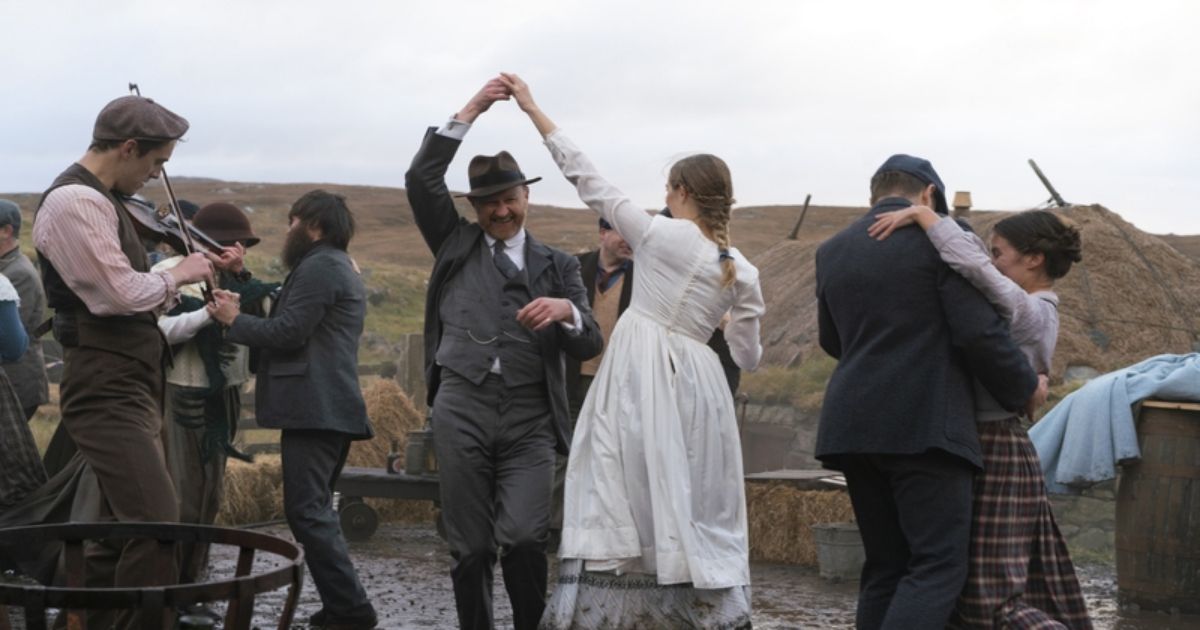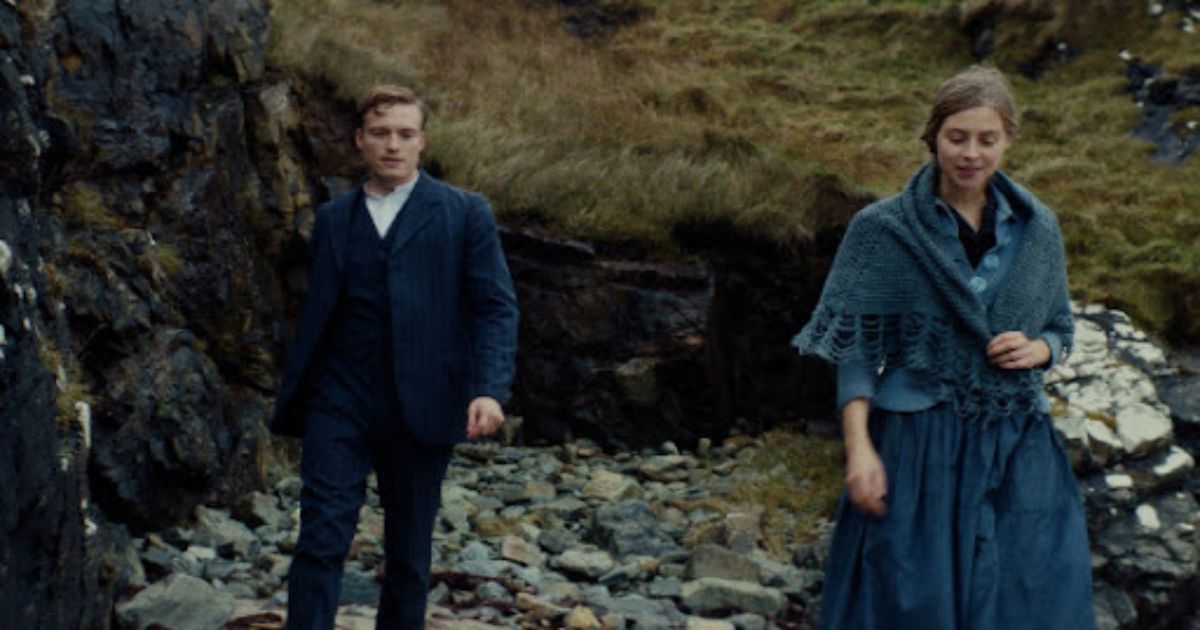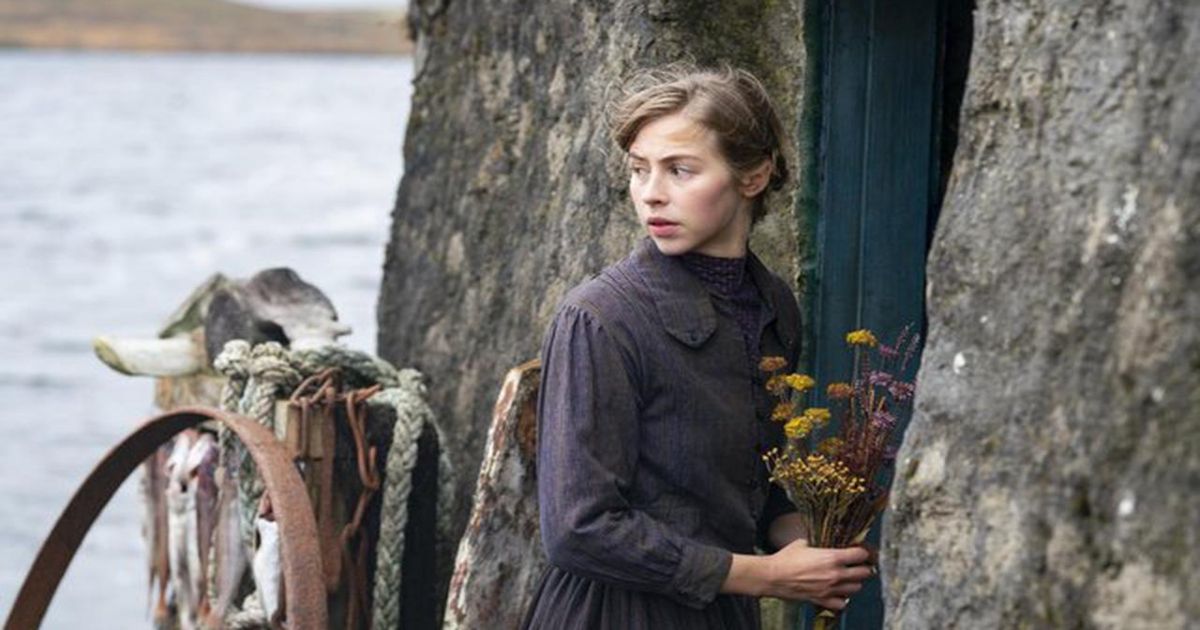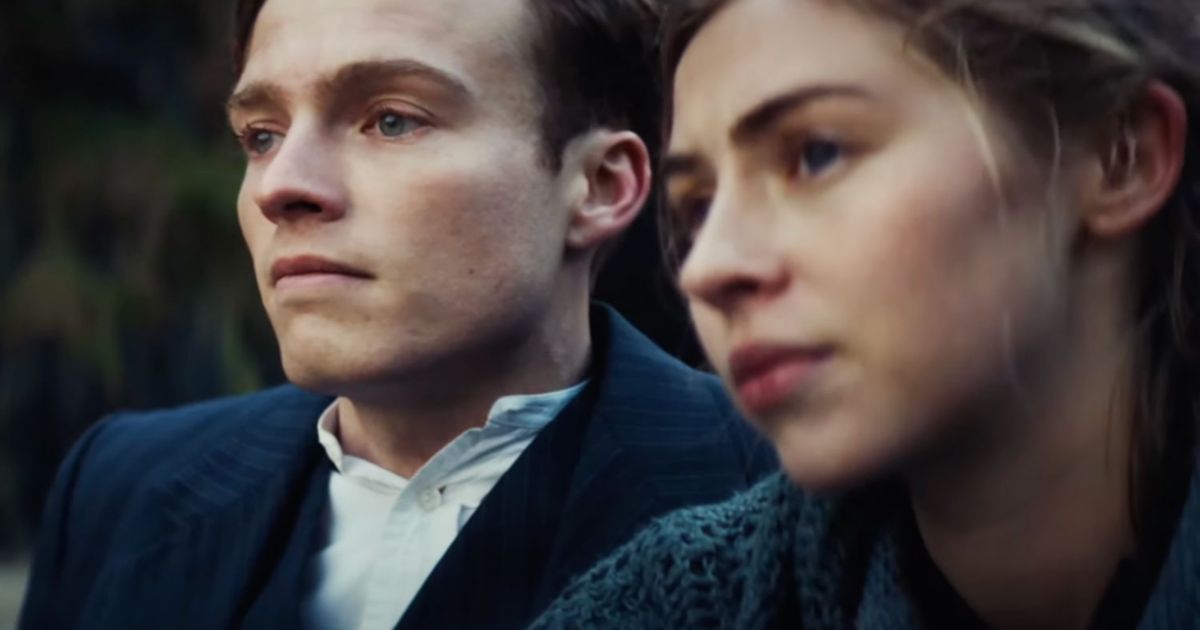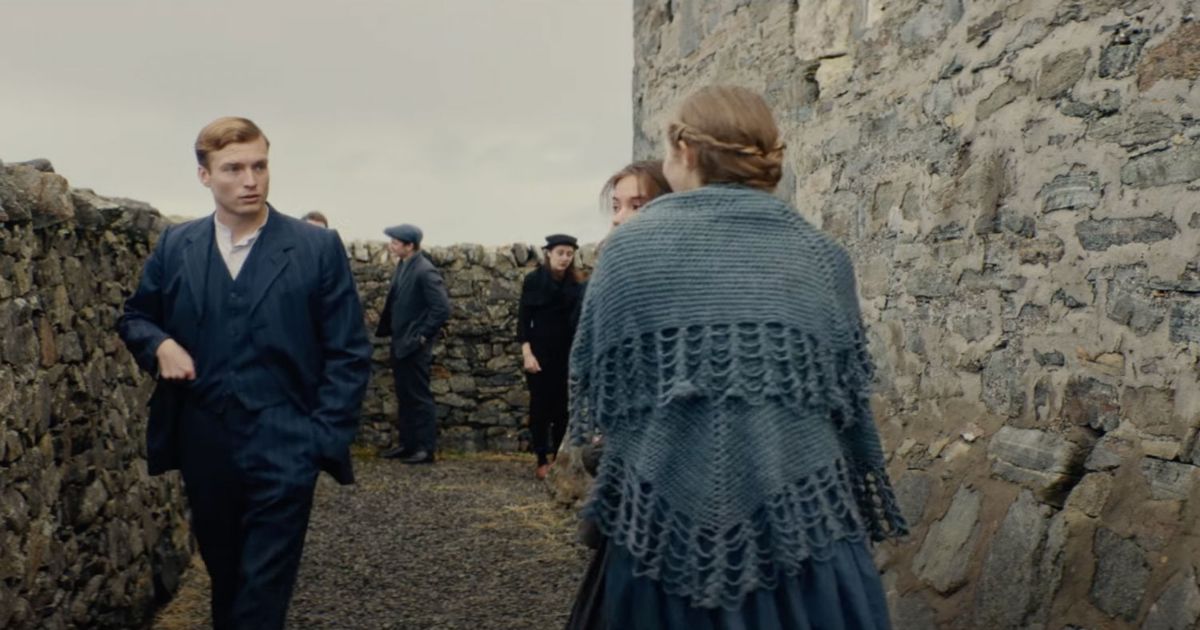The Road Dance is a beautiful, quiet film which takes place on the gorgeous and desolate Isle of Lewis in Scotland. Turbulent waves crash against its rocky peaks, causing a cacophony of sound starkly opposed to the quiet, diligent, and collegial citizens of its small town. These villagers in the early 20th century go about their day planting potatoes and praying, some dreaming of grander things, until word comes of war. All the young men gather to be sent out into the chaos of the first World War, an international battle which inaugurated a new kind of modernism incongruous to the peaceful life of these villagers.
Before they go, however, there is a road dance. The town gathers with whiskey and whimsy, dancing along to the hand-strummed local music and the occasionally emotional bagpipe ballad. The new film from Richie Adams chronicles the lead-up to this event for young protagonist Kirsty Macleod (poignantly played by Hermione Corfield), her brutal assault that night, and the emotional aftermath of the event the following months. It's an emotionally devastating movie but not a melodramatic one, taking a skilled look at abuse, trauma, female solidarity, and what it meant to be a woman in the early 20th century; it even makes us question what it means to be a woman today.
Richie Adams on Bringing The Road Dance to Life
The film is an adaptation of a book by journalist John MacKay, who studied the real-life history of his town and the story of his grandparents. "The first step was him reading the script," writer/director Richie Adams says, "and I was nervously awaiting his thoughts [...] he was very complimentary of the script."
Being an American, Adams wanted to make sure he captured the cultural specificity of Scotland in the early 20th century, something The Road Dance has a beautiful feel for. He brought in an authenticity expert with whom he worked closely, and spent some time before production with cinematographer Petra Korner, whose expertise in crafting the kind of antiquated fantasy worlds of the visually stunning TV shows Shadow and Bone and A Discovery of Witches lends itself well to the almost mythical splendor of the natural Scottish landscape. Adams says:
In terms of the look, I created a kind of Director's Presentation and picked from a palette from various periods. But mostly, I've been working as a title designer for 20-plus years, so I'm pretty careful to try not to match something that I've seen. I'd rather just go out and let the location and the content of that story kind of inform where we need to go. So when I connected with our DP Petra Korner, we walked around, we understood the official language of how we wanted to tell the story. That was part of a part of both of our processes, going off to the stills camera and kind of taking pictures of various locations, how we might frame certain scenes, and ultimately be interesting.
Importantly, they shot on location in the actual town of Garenin (or Gearrannan in Scottish Gaelic) on the gorgeous Isle of Lewis, at the authentic 'blackhouse village' built in the 1800s; they even filmed in the villagers' houses. "The producers approached the owners of the individual homes and asked, you know, 'could we go in and shoot?' And thankfully they said yes," Adams says. "So it was kind of a closed set. Everything was shot on location. I think that's why it comes out as authentic, because [...] shooting on the island was amazing." This dedication to the real thing comes across perfectly in the film, as if the story was stolen from time.
I wanted to depict the time period accurately. John Mackay had done an enormous amount of research which was great, that was already in the book. His grandparents actually grew up and lives in that village that the location at the bottom of the hill right at the base of the bay there, that's [their] home. [...] I spent a lot of time walking around and asking as many questions as I could.
Hermione Corfield on Creating Kirsty
Part of Adams' process is reliant upon his performers to tap into the authenticity he helps create. "I'm a big proponent of bringing the right players in and let them shine in their respective place where they work," he says, and he found the right player with Corfield. The talented and beautiful actor has appeared in some great recent British television, like We Hunt Together and The Halcyon, and has been taking off in America after her acclaimed performance in Rust Creek from 2018, following it by acting in The Misfits and starring in the incredible sci-fi horror movie Sea Fever.
She's tasked with a difficult job in The Road Dance, portraying an early 20th-century woman who is raped; she does an excellent job shifting the character from before to after the traumatic event, while fighting to not let it ultimately define her. As Corfield says:
Ritchie's script [...] had mapped out her journey already, and to me, it was kind of finding where she's still fighting and where she's lost all hope, and really, where rock bottom is for her, because there are so many different stages of her grief. [...] There's just so many different stages to her suffering and for me, it was trying to find that before and after. Before, she's got so much hope, this whole dream to go to America, she's full of that youthful thing of 'I can be whatever I want and do whatever I want.' And after, she believes that she can't do anything she wants to this is you know, this is her forever now, in this perpetual state of shame, basically. So yeah, it was kind of mapping out those different lights and shades.
When Corfield says that she "mapped out" the character, she means it literally, taking a dedicated approach to guarantee that she knew the emotional state of her character in every shot. "I literally mapped it out because I had to work out where her strength's at, where this journey's at," she says, which is important when you're shooting out of order. "Having a physical diagram to go okay, well, this has just happened, so where am I on the scale [...] I found that the most useful way, like a visual representation of Kirsty's journey." The actor's meticulous dedication to ensure accuracy, authenticity, and emotional resonance is similar to Adams'; she says:
There definitely is a responsibility to do it justice. It's a true story, I felt a responsibility for the audience to want to stay with her and want her to win and want her to fight. [..] What we wanted them to take from it was the sense of resilience and a sense of hope. This feeling that even in a time and a place where there was so much shame and pressure attached to being a woman, and then being a woman who is technically 'ruined,' that there is still a way out. I think, although it is set in that time, there's a lot that's extremely relevant still today, universally, not necessarily just for women, I think there is a sense of hope and forward motion and light at the end of the tunnel at the end of the film.
The Road Dance, Women, and Surviving Trauma
The Road Dance is so emotionally powerful (and a certified tearjerker in a wonderful way) because it uses its detailed authenticity and developed characters to reflect a pain that is still present in society and the daily lives of many. It doesn't say that the world of 2022 hasn't changed at all over a century, and is very historically and culturally aware, but it does inevitably comment on current discussions about abuse, victims, patriarchy, and shaming. Kirsty doesn't know who rapes her, and when she becomes pregnant, she's terrified of telling anyone in her small town. Religion, the male gaze, social conditioning, and the genuine fears of a young girl all come into play here as just a few of the many reasons Kirsty (and women today) can feel terrified of speaking out.
I think what was great about the script is that it's not trying to say that women thought the same way now as they did then. [The mom] says, "We're gonna hide you. We're going to hide the baby, and we're going to get rid of this problem, because you will be considered a whore." And I mean, that was the reality then, and I think there's tension and drama in the reality of what it was to be a woman then, and to modernize it too much and expect all the women's mentality to be what it is now, would be to take away the tension. It takes away the drama and the realism of that time. I wanted to play her as a forward-thinking woman and a fighter, but I didn't want her to be an entirely modern woman because that doesn't sit right with the time and also takes away the drama and the tension of the story.
"One of the reasons why Kirsty kind of keeps everything to herself," Adams says, "is not only the shame that would surround what happened to her, but the fact that she chooses not to have her family carry the same burden that she had." Adams and Corfield, along with many others, created a tender and authentic world (helped by the cast and crew staying together in nearby Stornoway); as a result, the characters who come to life off the page and from the true story were inspiring and beautiful, surprising even the director himself. "I was ultimately able to see the power of this female group of a mother and her two daughters, the two sisters, that were just fearlessly supportive of one another once the truth came out, and that was just a beautiful thing to watch[...] I could see that truth was there with those three."
The Road Dance really comes alive thanks to these characters, movingly played by Morven Christie and Ali Fumiko Whitney; the British comedy legend Mark Gatiss delivers a wonderful performance as well, and so does Will Fletcher as the man Kirsty really loves. The film is largely Corfield's though, who populates just about every scene. "With Hermione, I wrote the screenplay, but I trusted that she would bring the character and this person to life," Adams says. MacKay, who wrote the book and based it off the stories he heard growing up, seems to think that she did. Corfield said that MacKay sent her a message, saying, "he can now see me as Kirsty, which is a lovely thing to say, that I was now the Kirsty he imagined. John's just an extraordinarily kind, incredibly kind person."
The Road Dance has the capability of making its audiences kinder, too. The Road Dance premiered at the Edinburgh Film Festival to strong reviews (with a 100% Rotten Tomatoes rating as of March 19) and is set to be released theatrically in May.

